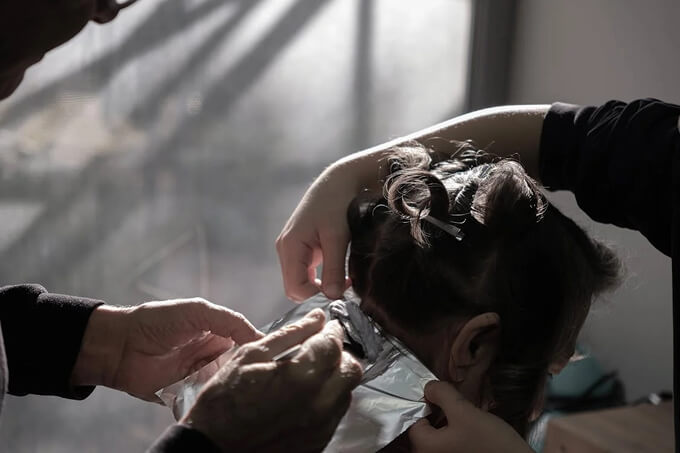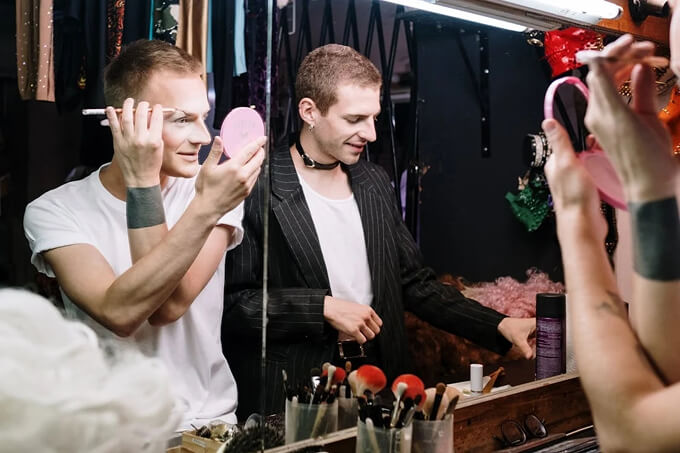What Are the Modern Non-Surgical Hair Replacement Techniques?
- Written by Leo Lordhair
- Feb 16, 2025
- |
- 9 min read
 Listen to the full text
Listen to the full textWhether one is a male or female, losing hair is a global issue. According to data provided by the International Society of Hair Restoration Surgeons, hair restoration services are sought out by roughly two million patients every year.
A wide array of non-surgical methods allow one to combat hair loss without the need for invasive techniques, and as the need to have a full head of hair increases, so does the need to use these methods. In this blog, we try to understand the new age non-surgical methods of hair replacement, and how they are changing the world around us.
1. Modern Wigs and Toupees

The experience of visiting a hair restoration clinic has changed over the past few years, with the most recent advances in technology. Everything from bulky and old fashion wigs that didn’t look real now exist in the past! Advanced materials have been introduced that make these pieces look exactly like hair.
Most modern systems including hair wigs are made of ultra thin, breathable materials such as lace or poly which adhere to the scalp, as well as monofilament. These types allow for seamless skin integration. These bases are then hand tied with Human hair or high quality synthetic fibers, allowing them to blend in naturally with existing hair.
Benefits:
- Painless application means zero recovery time from surgery.
- Their use is completely customizable allowing them to be matched to any hair color, texture, and density.
- Treated the same way normal hair is maintained.
2. Scalp Micropigmentation (SMP)
In the last couple of years, Scalp Micropigmentation has emerged as one of the best innovative non-surgical procedures. This process seeks to replicate the appearance of hair by imitating the hair follicles. Micro-needles are used to introduce small amounts of pigment into the surface of the scalp with the intention of replicating hair follicles.
Benefits:
- Can be seen immediately.
- There is no need for daily upkeep, there is no downtime involved, and there are no risks tied to surgery.
- This is useful for patchy hair thinning and total loss of hair.
3. LLLT (Laser hair therapy)
Modern Low-Level Laser Therapy (LLLT) devices come in the form of comfortable caps and helmets equipped with medical-grade LED lights. Research by Drs Lueangarun and Visutjindaporn at Chulabhorn International College of Medicine indicates that laser therapy using low-intensity light can help women experiencing this type of hair loss.
These devices now incorporate smart technology that tracks treatment sessions and adjusts light intensity based on individual needs.
Benefits:
- Safety is guaranteed as it is approved by FDA.
- Home treatment is preferred by many clients, which increases its popularity.
- There is no need for post treatment healing, which makes it more appealing and alluring.
4. Platelet-Rich Plasma (PRP) Therapy
Being a new technique of accelerating hair growth, PRP therapy makes use of the inherent capacity of the body to heal itself. To begin the process, a small sample of the patient’s blood is collected and spun in a centrifuge to separate it into its individual components. Afterward, it is injected into specific areas in the scalp, enabling the development of new hair follicles. Sessions are done every 4–6 weeks with results typically visible after a few months.
Benefits:
- Since it is derived from your own body, it reduces any chances of rejection.
- Each session lasts less than an hour.
- Result within 3–4 months.
5. Hair Building Fibers
Hair building fibers are a great option for people with bald patches and those who have little time to dedicate to styling. It is made of keratin or any other natural fiber and is sprinkled on the bald patch. Each strand of hair binds to the fiber using static electricity. This way, the bald patch is covered for a fuller look.
Benefits:
- Can be simply applied and removed when necessary.
- They are ideal for special events or daily use.
- Cost-effective and readily available.
6. Advanced Topical Treatments
Modern hair loss topical treatments are a step ahead from the ordinary minoxidil. This category of treatment often works best during early stages of hair thinning as it holds on to the existing hair while promoting new growth. Stem cell extracts, peptides, growth factors, and other latest products work into the hair follicles at micro level to aid in hair growth.
Benefits:
- Works best for all hair types.
- Can be in aid with other treatments to yield better results.
- Integration into daily activities is effortless as the procedure is non-invasive.
7. 3D-printed Hair Prosthetics
Works for both men and women; 3D printed hair prosthetics are custom made for each client. The prosthesis is designed to contour to the shape of the scalp for a secure fit and natural look. This technology is emerging along with the increased accessibility and affordability, which looks hopeful for the future.
Benefits:
- Provides videos as a durable remedy.
- Great for people who have specialized needs
- For any man or woman wanting hair, design simulating hair makes it comfortable.
8. Threads made of Polydioxanone (PDO)
Additionally, PDO threads have recently been popularized for hair restoration using a technique known as Thread Embedding Therapy (TET). These threads are very thin and absorbable so they can easily be placed just under the scalp. Collagen, blood, and fibroblast are produced at a staggering rate and they increase hair growth. PDO threading is a great option for those suffering from androgenic alopecia or hair thinning because of its low side effects and quick results.
Benefits:
- Minimal recovery period post-surgery and patients can get back to their daily routine quickly.
- Encourages self hair restoration.
- Can be used in conjunction with other hair loss therapies.
9. Nourishing Serums and Cold Laser Therapy
There is a new and modern hybrid version of cold laser therapy which includes infusion of nutrients. This non-invasive hairstyle replacement technique is on the rise. During this procedure, the hair follicles are targeted with low lasers to open them. Afterwards, serums with high concentration of nutrients are applied to the scalp to nourish it.
Benefits:
- Boosts the scalp's self-nourishing ability and encourages growth.
- Non-invasive with no downtime.
- Can be tailored to individual hair loss conditions.
10. Oral Finasteride

Finasteride is a pill used to treat male pattern baldness (androgenetic alopecia) and benign prostatic hyperplasia (BPH). In the opinion of the National Library of Medicine: These conditions are treated with drugs which inhibit the enzyme 5-alpha reductase which lowers the quantity of testosterone converted to dihydrotestosterone (DHT) hormone that causes loss of hair.
Benefits:
- Reduces DHT and promotes hair regrowth
- Medications for benign prostatic hyperplasia (BPH)
- Alleviation of hormonal changes/imbalance responsible for hair loss which is mediated through DHT.
Selecting an Appropriate Method
The possibility of using various non-invasive methods of hair replacement makes selection dependent on individual preferences, personal lifestyle and the amount of money to be spent. It is very important to get help from a hair restoration professional in assessing the cause of your hair loss and determining the most effective remedy.
Factors to consider include:
- Severity and type of hair loss.
- Desired results and maintenance requirements.
- Long-term vs. temporary solutions.
Conclusion
Modern non-surgical hair replacement techniques provide renewed hope and confidence for those facing hair loss. Innovative hair restoration methods such as scalp micropigmentation, PRP therapy, 3D-printed prosthetics and others provide solutions for everyone. These advancements not only deliver natural-looking results but also help people regain their self-esteem without invasive surgery.


